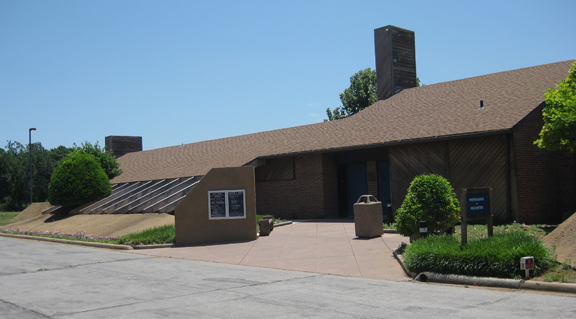|
Alice Littleman
Alice Littleman (February 8, 1910 – May 26, 2000) was a Kiowa beadwork artist and regalia maker, who during her lifetime was recognized as one of the leading Kiowa beaders and buckskin dressmakers. Her works are included in the permanent collections of the National Museum of Natural History, the National Museum of the American Indian, the Southern Plains Indian Museum, and the Oklahoma Historical Society. Early life Alice Jones was born on February 8, 1910, in the Old Town district of Anadarko, Oklahoma, to To-haddle-mah (English name: Anna Konad) and Tommy Jones. She was the second child in a family of three other siblings: Mary Hummingbird (b. 1907), Iva Jones (1912–1914), and Vernon S. Keahbone (b. 1919). They grew up on their maternal grandparents' land in West McKinley Township, Caddo County, Oklahoma, about five miles northwest of Anadarko. Her family was Kiowa and descended of Tohausen III, through her grandfather Konad (White Buffalo). Her grandmother Dome-be-ah-ty, t ... [...More Info...] [...Related Items...] OR: [Wikipedia] [Google] [Baidu] |
Anadarko, Oklahoma
Anadarko is a city in Caddo County, Oklahoma, United States. The city is fifty miles southwest of Oklahoma City. The population was 5,745 at the 2020 census. It is the county seat of Caddo County. History Anadarko got its name when its post office was established in 1873. The designation came from the Nadaco Native Americans, a branch of the Caddo Nation, and the "A" was added due to a clerical error.Carolyn Riffel and Betty Bell, "Anadarko." ''Encyclopedia of Oklahoma History and Culture''. Accessed April 17, 2015. In 1871, the Wichita Agency was reestablished on the north bank of the Washita River after being destroyed in the |
Gallup Inter-tribal Indian Ceremonial , a historic house in Jefferson, Iowa, United States
*
{{disambiguation ...
Gallup may refer to: *Gallup, Inc., a firm founded by George Gallup, well known for its opinion poll *Gallup (surname), a surname *Gallup, New Mexico, a city in New Mexico, United States **Gallup station, an Amtrak train in downtown Gallup, New Mexico *Gallup International Association, a group of polling organizations registered in Zurich, Switzerland * USS ''Gallup'', various ships of the United States Navy *Gallup Korea, a South Korean research company founded by Park Moo-ik See also *Gallop (other) *Gallup & Robinson, a marketing research company *George H. Gallup House The George H. Gallup House built in 1901 is an historic octagonal house located at 703 South Chestnut Street in Jefferson, Iowa, United States. It was the birthplace and boyhood home of Dr. George Horace Gallup, the pioneer of public opinion po ... [...More Info...] [...Related Items...] OR: [Wikipedia] [Google] [Baidu] |
Delaware Nation
Delaware Nation ( del, Èhëliwsikakw Lënapeyok), also known as the Delaware Tribe of Western Oklahoma and sometimes called the Absentee or Western Delaware, based in Anadarko, OklahomaDelaware Tribe regains federal recognition. ''NewsOk.'' 4 Aug 2009 (retrieved 5 August 2009) is one of three of in the United States, along with the Delaware Indians based in Bartlesvill ... [...More Info...] [...Related Items...] OR: [Wikipedia] [Google] [Baidu] |
Comanche Nation
The Comanche or Nʉmʉnʉʉ ( com, Nʉmʉnʉʉ, "the people") are a Native American tribe from the Southern Plains of the present-day United States. Comanche people today belong to the federally recognized Comanche Nation, headquartered in Lawton, Oklahoma. The Comanche language is a Numic language of the Uto-Aztecan family. Originally, it was a Shoshoni dialect, but diverged and became a separate language. The Comanche were once part of the Shoshone people of the Great Basin. In the 18th and 19th centuries, Comanche lived in most of present-day northwestern Texas and adjacent areas in eastern New Mexico, southeastern Colorado, southwestern Kansas, and western Oklahoma. Spanish colonists and later Mexicans called their historical territory '' Comanchería''. During the 18th and 19th centuries, Comanche practiced a nomadic horse culture and hunted, particularly bison. They traded with neighboring Native American peoples, and Spanish, French, and American colonists and set ... [...More Info...] [...Related Items...] OR: [Wikipedia] [Google] [Baidu] |
Cheyenne And Arapaho Tribes
The Cheyenne and Arapaho Tribes are a united, federally recognized tribe of Southern Arapaho and Southern Cheyenne people in western Oklahoma. History The Cheyennes and Arapahos are two distinct tribes with distinct histories. The Cheyenne (Tsitsistas/ The People) were once agrarian, or agricultural, people located near the Great Lakes in present-day Minnesota. Grinnell notes the Cheyenne language is a unique branch of the Algonquian language family and, The Nation itself, is descended from two related tribes, the Tsitsistas and the Suh' Tai. The latter is believed to have joined the Tsitsistas in the early 18th century (1: 1–2). The Tsitsistas and the Suh' Tai are characterized, and represented by two cultural heroes who received divine articles which shaped the time-honored belief systems of the Southern and Northern families of the Cheyenne Nation. The Suh' Tai, represented by a man named Erect Horns, were blessed with the care of a sacred Buffalo Hat, which is kept among ... [...More Info...] [...Related Items...] OR: [Wikipedia] [Google] [Baidu] |
Caddo Nation
The Caddo people comprise the Caddo Nation of Oklahoma, a federally recognized tribe headquartered in Binger, Oklahoma. They speak the Caddo language. The Caddo Confederacy was a network of Indigenous peoples of the Southeastern Woodlands, who historically inhabited much of what is now East Texas, west Louisiana, southwestern Arkansas, and southeastern Oklahoma. Prior to European contact, they were the Caddoan Mississippian culture, who constructed huge earthwork mounds at several sites in this territory, flourishing about 800 to 1400 CE. In the early 19th century, Caddo people were forced to a reservation in Texas. In 1859, they were removed to Indian Territory. Government and civic institutions The Caddo Nation of Oklahoma was previously known as the Caddo Tribe of Oklahoma. The tribal constitution provides for election of an eight-person council, with a chairperson. Some 6,000 people are enrolled in the nation, with 3,044 living within the state of Oklahoma. [...More Info...] [...Related Items...] OR: [Wikipedia] [Google] [Baidu] |
Seed Beads
Seed beads or rocailles are uniformly shaped, spheroidal beads ranging in size from under a millimeter to several millimeters. ''Seed bead'' is also a generic term for any small bead. Usually rounded in shape, seed beads are most commonly used for loom and off-loom bead weaving. They may be used for simple stringing, or as spacers between other beads in jewelry. Larger seed beads are used in various fiber crafts for embellishment, or crochet with fiber or soft, flexible wire. The largest size of a seed bead is 1/0 ("one-aught", sometimes written 1/°) and the smallest is 24/0, about the size of a grain of sand.Weiss, Lesley"Seed Beads."''The Best of Bead and Button Magazine.'' Page 7 (retrieved 17 June 2011) However, seed beads that are size 5/0 or 6/0 are usually called "pony beads" rather than "seed beads"; the next larger class of seed beads, from 3/0 to 4/0, are usually called "trade beads"; the largest class of seed beads, including 1/0, 2/0, and anything larger, are usuall ... [...More Info...] [...Related Items...] OR: [Wikipedia] [Google] [Baidu] |
National Cowboy Hall Of Fame
The National Cowboy & Western Heritage Museum is a museum in Oklahoma City, Oklahoma, United States, with more than 28,000 Western and American Indian art works and artifacts. The facility also has the world's most extensive collection of American rodeo photographs, barbed wire, saddlery, and early rodeo trophies. Museum collections focus on preserving and interpreting the heritage of the American West. The museum becomes an art gallery during the annual Prix de West Invitational Art Exhibition and Sale each June. The Prix de West Artists sell original works of art as a fund raiser for the museum. The expansion and renovation was designed by Curtis W. Fentress, FAIA, RIBA of Fentress Architects. History The museum was established in 1955 as the Cowboy Hall of Fame and Museum, from an idea proposed by Chester A. Reynolds, to honor the cowboy and his era. Later that same year, the name was changed to the National Cowboy Hall of Fame and Museum. In 1960, the name was changed ... [...More Info...] [...Related Items...] OR: [Wikipedia] [Google] [Baidu] |
Indian Arts And Crafts Board
The Indian Arts and Crafts Board (IACB) is an agency within the United States Department of the Interior whose mission is to "promote the economic development of American Indians and Alaska Natives through the expansion of the Indian arts and crafts market." It was established by Congress in 1935. It is headquartered at the Main Interior Building in Washington, DC. Scope The board provides advice and promotional activities and oversees the implementation of the Indian Arts and Crafts Act of 1990, a truth-in-advertising law attempting to stop non-Native-made artworks from being sold as Native-made. The IACB also operates three museums: * Sioux Indian Museum, housed in the Journey Museum in Rapid City, South Dakota * Museum of the Plains Indian in Browning, Montana * Southern Plains Indian Museum Southern Plains Indian Museum is a Native American museum located in Anadarko, Oklahoma. It was opened in 1948 under a cooperative governing effort by the United States Depar ... [...More Info...] [...Related Items...] OR: [Wikipedia] [Google] [Baidu] |
Southern Cheyenne
The Cheyenne and Arapaho Tribes are a united, federally recognized tribe of Southern Arapaho and Southern Cheyenne people in western Oklahoma. History The Cheyennes and Arapahos are two distinct tribes with distinct histories. The Cheyenne (Tsitsistas/ The People) were once agrarian, or agricultural, people located near the Great Lakes in present-day Minnesota. Grinnell notes the Cheyenne language is a unique branch of the Algonquian language family and, The Nation itself, is descended from two related tribes, the Tsitsistas and the Suh' Tai. The latter is believed to have joined the Tsitsistas in the early 18th century (1: 1–2). The Tsitsistas and the Suh' Tai are characterized, and represented by two cultural heroes who received divine articles which shaped the time-honored belief systems of the Southern and Northern families of the Cheyenne Nation. The Suh' Tai, represented by a man named Erect Horns, were blessed with the care of a sacred Buffalo Hat, which is kept among th ... [...More Info...] [...Related Items...] OR: [Wikipedia] [Google] [Baidu] |
Apache
The Apache () are a group of culturally related Native American tribes in the Southwestern United States, which include the Chiricahua, Jicarilla, Lipan, Mescalero, Mimbreño, Ndendahe (Bedonkohe or Mogollon and Nednhi or Carrizaleño and Janero), Salinero, Plains (Kataka or Semat or " Kiowa-Apache") and Western Apache ( Aravaipa, Pinaleño, Coyotero, Tonto). Distant cousins of the Apache are the Navajo, with whom they share the Southern Athabaskan languages. There are Apache communities in Oklahoma and Texas, and reservations in Arizona and New Mexico. Apache people have moved throughout the United States and elsewhere, including urban centers. The Apache Nations are politically autonomous, speak several different languages, and have distinct cultures. Historically, the Apache homelands have consisted of high mountains, sheltered and watered valleys, deep canyons, deserts, and the southern Great Plains, including areas in what is now Eastern Arizona, Norther ... [...More Info...] [...Related Items...] OR: [Wikipedia] [Google] [Baidu] |
Washita, Oklahoma
Washita is a rural community in Caddo County, Oklahoma, United States. It is located west of Anadarko on a bend in the Washita River. The post office opened April 16, 1910. A municipal electrical power generation plant for Anadarko is located in Washita. It is zoned to Anadarko Public Schools The Anadarko Independent School District, also known as Anadarko Public Schools, is a school district based in Anadarko, Oklahoma United States. In addition to Anadarko it serves Washita. Schools ; Secondary schools * Anadarko High School * .... Demographics References Unincorporated communities in Caddo County, Oklahoma Unincorporated communities in Oklahoma {{Oklahoma-geo-stub ... [...More Info...] [...Related Items...] OR: [Wikipedia] [Google] [Baidu] |







